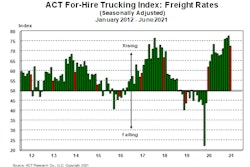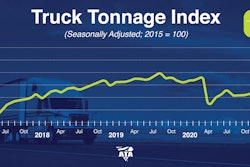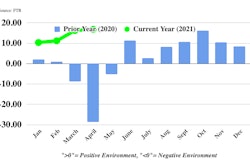
While the historically tight, and expensive, market for moving freight across land regularly makes headlines in the trucking community, the situation at ports and at sea threatens to send tidal waves through consumer prices.
The rules in the import game have changed, an administrator with a major trucking supply company told Commercial Carrier Journal on condition of anonymity. This means no more COD payments for imported containers and no more guarantees of getting a spot on a freighter. The source has seen an 445% uptick in import container costs, which will be passed along to customers. The equipment his company imports is used by trucking companies throughout the U.S.
“The only way the forwarder says they can get space on the ship is to prepay, and the prepaid rate right now they're quoting me is about $30,000,” the administrator said. “That same container 10, 11, 12 months ago was about $5,500.”
With demand soaring for new and used trucks, companies that support that equipment with everything from spare parts to radios, ELDs and floor mats have little choice but to pony up and pay historically high container prices.
“Personally, I don't see any relief in sight and there are rumors that maybe even a number of $40,000 per container is on the table,” said Siegfried Adam Jr., director of business development at Peter Wittwer North America, a customs house broker in Largo, Florida.
“There's no global governing body that would put the kibosh on this,” Adam continued. “There is nobody that says, 'Okay. This is enough.'”
Adam said some of his customers in the parts business have been feeling the pinch.
"We have quite a few customers [importing] aftermarket parts for heavy earth-moving machinery like dozers and excavators," Adam said. "These containers that we bring in have an average value of $45,000. So all of a sudden 60% to 75% of that is your logistics costs. And, you know, these price increases have to be handed down to everybody."
It’s not just higher parts prices companies have to be concerned about, it’s supply levels as well. Nimesh Modi, CEO of Book Your Cargo in New York City, said some companies have turned to doubling up on orders over concerns of supply chain constraints.
Deliveries are being further hampered by China’s closure of port terminals following concerns over the spread of COVID-19.
In a story published Sept. 9 in the American Journal of Transportation, NRF Vice President for Supply Chain and Customs Policy Jonathan Gold said, "we’re seeing issues ranging from port closures in Asia to ships lined up waiting to dock at U.S. ports. That’s creating continuing challenges as retailers work to supply enough inventory to meet demand.”
Modi said he’s experiencing supply shortages firsthand on items that typically haven’t been marred by scant inventory levels in the past.
“I wanted to buy a simple dishwasher,” Modi explained. “They said, ‘Fine, we can guarantee you delivery 8 or 9 months down the road.’ This tells us the supply chain is completely disrupted now.”
Help on the way?
Gold said the Biden administration’s “recent appointment of a supply chain task force and a port envoy” are “major steps forward” in helping to alleviate port challenges like soaring container costs.Gene Seroka, executive director of the Port of Los Angeles where freight volume jumped 37% year over year in July, shared his enthusiasm.
“The spotlight is on us directly from the president of the United States, and we're taking advantage of it,” Seroka said during the port’s most recent press conference. “We've been meeting directly with cabinet members and senior officials in Washington, Sacramento and points beyond. We're also working across the C-suite in the private sector. We've got big thinkers at the table to challenge exactly what's happening today and what we need to do for tomorrow.”
Not everyone, however, is banking on the Biden administration to solve all of the nation’s supply chain issues particularly as it relates to China.
“I doubt that the Biden administration is going to intervene with China in any way at all. I highly doubt it,” Adam said. “We still have tariffs against Chinese products. The Chinese are not going to be willing to talk trade until these tariffs are gone.”











